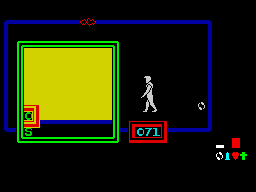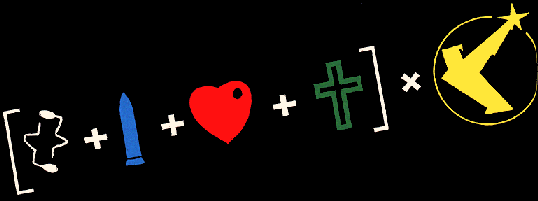
Rooms iris out — which will you choose? But even the rooms fire at you. In this shot, the ‘love bar’ has gained some points.

Possibly the oddest tie-in yet between a computer game and its original inspiration must be FRANKIE GOES TO HOLLYWOOD THE GAME designed by DENTON DESIGNS and produced by OCEAN. In an exclusive CRASH preview, we bring you a glimpse behind the scenes and a chance to see some of the screens in what could well become a classic.
Faced with one of the more outrageous pop bands of recent years, how do you turn them into a computer game? This is the nightmare that faced the Denton Designs team when Ocean’s David Ward blithely announced that Ocean had signed a deal with the management of Frankie Goes to Hollywood to produce a computer game based on the group. The brief was simple and to the point according to Steve Cain. ‘David walked in and said he wanted a game with no Frankies walking about in it.’ This was quite a bit before Christmas, when Dentons started to think seriously about how to go about the game, and the first step was to immerse themselves in the Frankie ethic.
‘We didn’t want to turn out the game I’m sure everyone expected,’ says Ally Noble, graphics artist for the Spectrum version, ‘a platform game with the group jumping around the place. Ocean announced that the Frankie game would be previewed at the LET show, so we thought we would pop down to see what it ought to look like!’
Needless to say, Frankie wasn’t ready for the LET, indeed the ideas hadn’t even fully gelled by then!
As designers of games like Gift from the Gods and the amazing new Shadowfire, it isn’t surprising that the team should continue along similar lines both visually and technically; ‘It’s a lot of games within games, mazes within mazes,’ says John Gibson, programmer of the Spectrum version. It is also, as far as I know, the first computer game to feature a ‘MacGuffin’.

The film director Alfred Hitchcock used MacGuffins a lot and probably invented the name — MacGuffin, like ‘John Doe’ is a sort of unidentified murder victim at the beginning of a film. The audience think they are settling down to watch a murder mystery, but the murder and victim are merely excuses to start a story that has very little to do with the murder. MacGuffins tend to disappear soon after the film gets under way because the audience becomes so enthralled with the actual story that they forget about them.
Frankie also starts out with a murder mystery to solve, but as the game progresses, solving it merely becomes one of many equally important tasks. You are the shadowy figure of the Frankie ‘Equation’, almost a non-person, living a mundane existence in Everydays-Ville, a boring suburb where nothing exciting ever happens — until a murder takes place. Looming over Everydays-Ville is the enticing shadow of the Pleasuredome — a symbol for modern day escapism. To relieve the boredom of Everydays-Ville you escape through TVs and computers, getting involved with fast arcade games until you realise that you can become a complete, well formed person fit to enter the very centre of the Pleasuredome.
Frankie has many layers to it. On the outside is Everydays-Ville, a street of houses which may be entered, containing rooms which may also be entered. Objects can be collected to help with your tasks, fittings like TVs and computers are magical entryways into the Pleasuredome. Inside the Pleasuredome are more layers, rooms with arcade games and puzzles to solve. With every achievement your personality file grows, shown by the Equation’s four bar charts. Succeeding at the puzzles and games takes you deeper, into a 3D maze with very few exits, but the exits to other rooms increase with your achievements too, making the push to become a complete personality easier.

Rooms iris out — which will you choose? But even the rooms fire at you. In this shot, the ‘love bar’ has gained some points.

A typical boring sitting room in Everydays-Ville, but there’s magic everywhere...
There are characters in the game as well, representing good and evil, and your dealings with these will determine whether your points increase or go down. Eventually you will achieve enough personality points to enter the centre of the Pleasuredome for the finale.
The graphics Dentons have designed draw heavily on the imagery of Frankie Goes to Hollywood. Large artbooks lie around on tables as reference for cherubs, an idea developed from The Power of Love video; the scene becomes an arcade sequence where you have to hop along passing clouds while the cherubs fire arrows at you from the side. ZTT’s logo becomes a complex little jigsaw puzzle. Frankie’s Liverpudlian background is also used, which suits Dentons as they are based in Liverpool, when you have to stop the bombers from destroying Merseyside, scoring points for every important site saved. In a shooting gallery, familiar faces pop up, Maggie, Ronnie, Andy Warhol and others. The game’s graphics owe something to those of Shadowfire (although Frankie isn’t exactly icon-driven), with rooms irising out over the former background, allowing your character to enter them. The ideas in Shadowfire were worked out in great detail, according to Steve; ‘We wanted to have a sequel to develop the ideas, and if Shadowfire was part one, Frankie is part two. But the things in Frankie have been put in spontaneously, unlike Shadowfire, so Frankie is more varied.’
Variety is certainly the key word in this highly unusual game which has surely gone far beyond what anyone responsible for setting up the deal ever expected. Asked two months ago what on earth the game would be like, Ocean’s David Ward smiled with confidence and replied that it would be — well — fabulous. His confidence appears not to have been misplaced.
